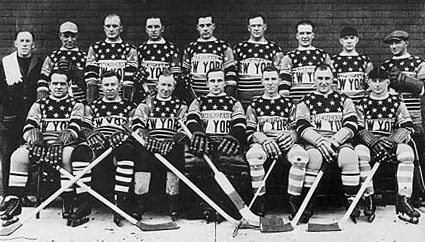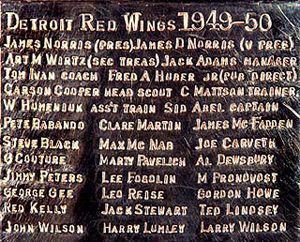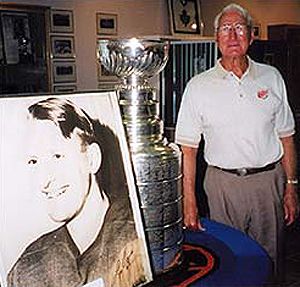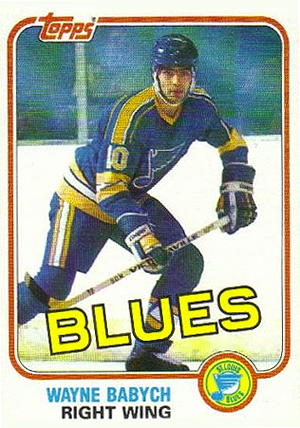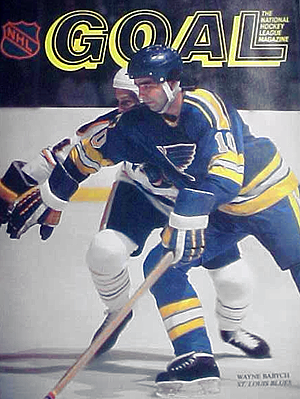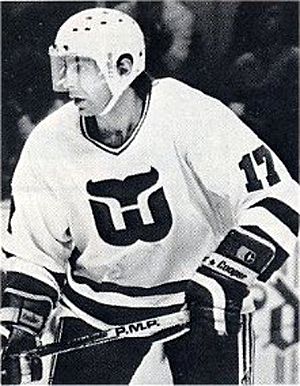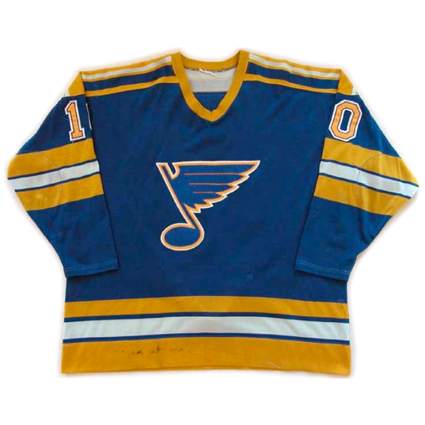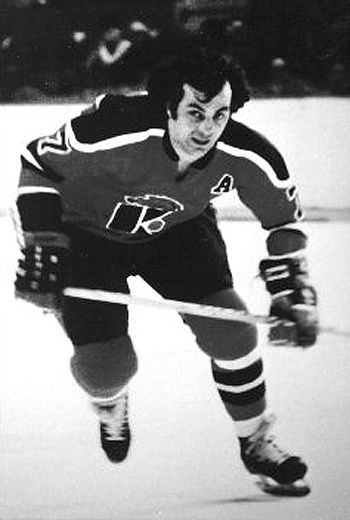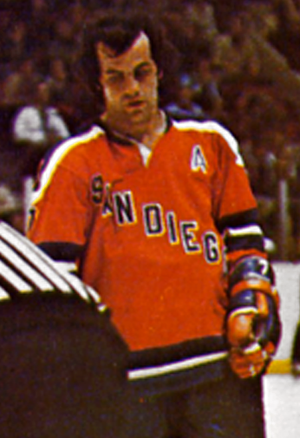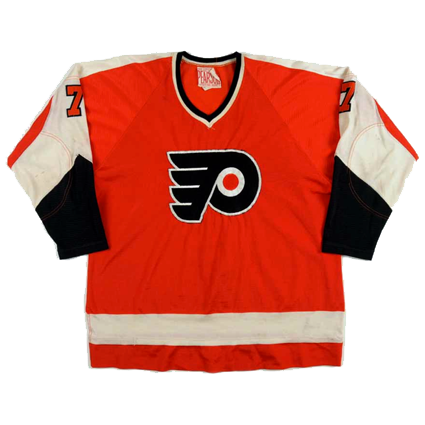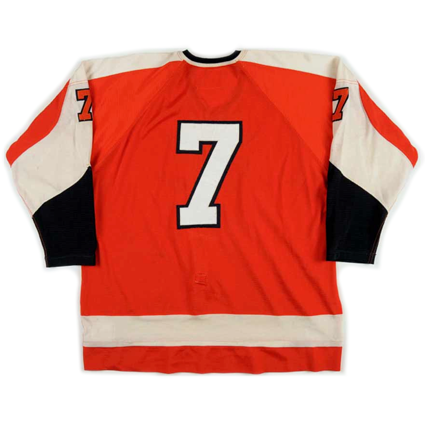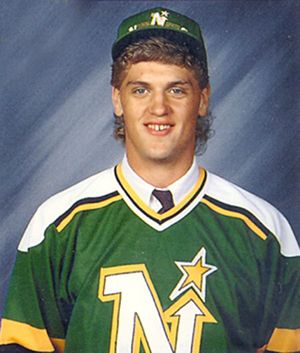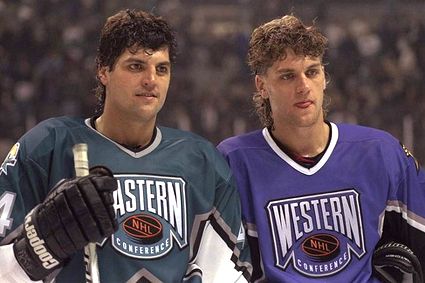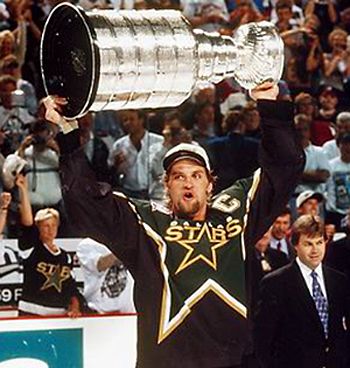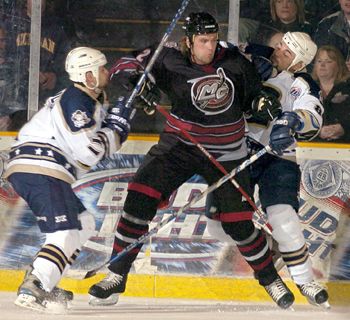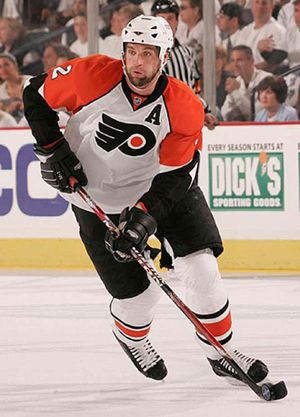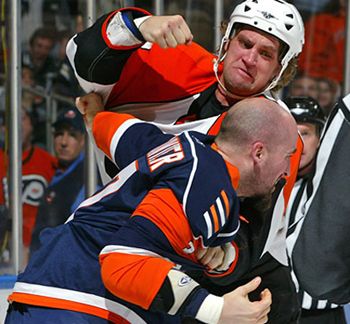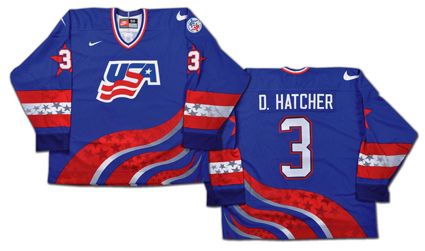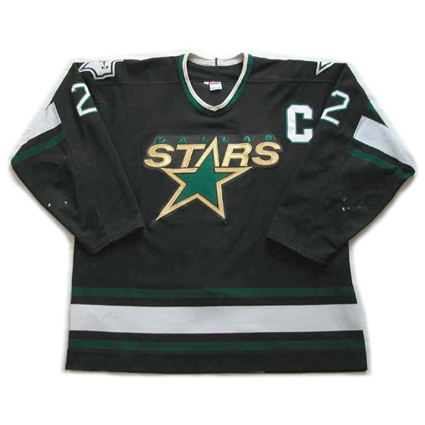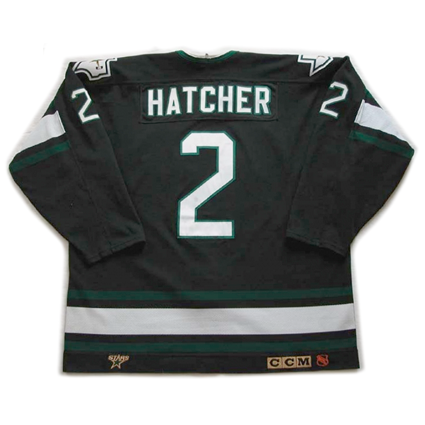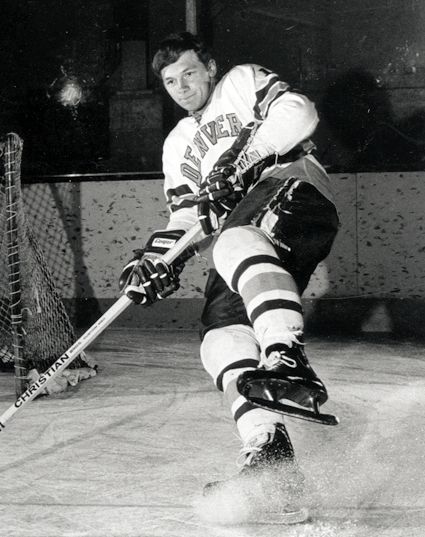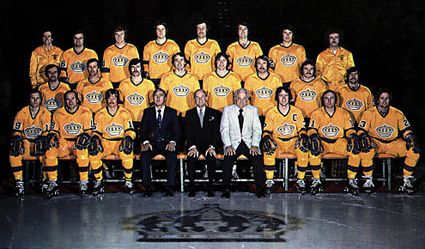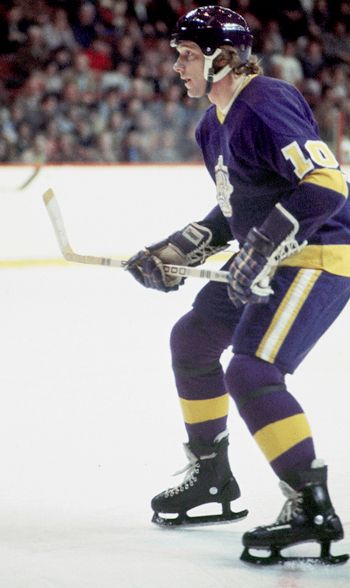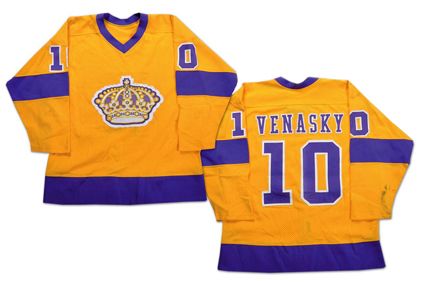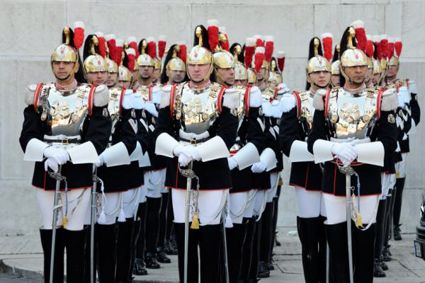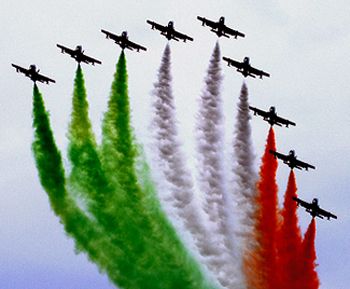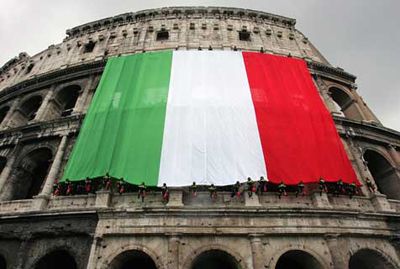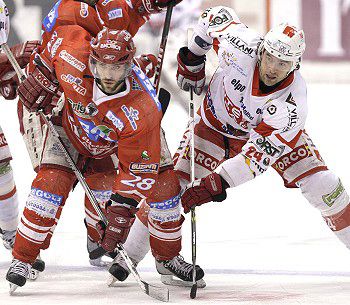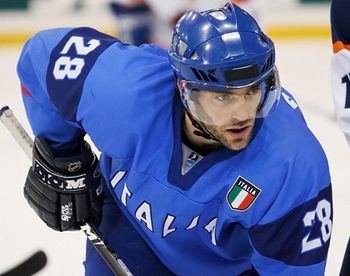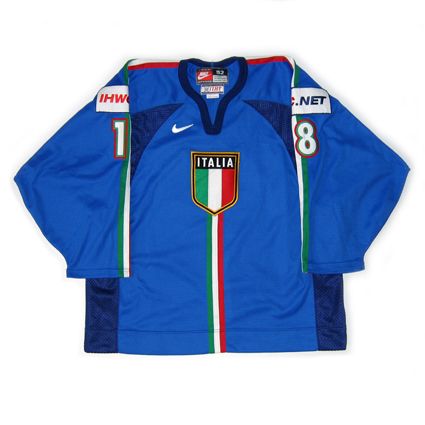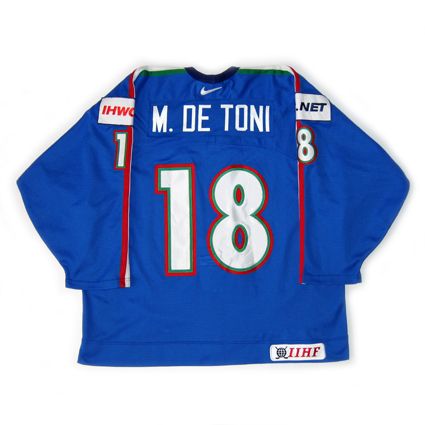Saturday, June 7, 2014
1951-52 Detroit Red Wings Leo Reise, Jr. Jersey
Leo Reise, despite having vision in only one eye since his youth, played for the Hamilton Tigers, first in the Ontario Hockey League beginning in 1914, and then later in the NHL starting with the 1920-21 season. It was after this season that he became the father of Leo Reise, Jr. on this date in 1922. After two more seasons with the Tigers, he was then traded to the Saskatoon Crescents of the WCHL where he played for three seasons before returning to the NHL with the New York Americans for three and a half seasons prior to a half season with the New York Rangers. He then spent two seasons in the IHL with Pittsburgh before retiring. Reise, a defenseman, played eight seasons in the NHL, totaling 223 games, scoring 36 goals and 29 assists for 65 points.
1926-27 New York Americans - Leo Reise, Sr. back row, third from left
Leo Reise, Jr. followed in his father's footsteps, orginally playing junior hockey in Brantford and Guelph prior to joining the Navy and playing for teams in Victoria, Halifax and Winnipeg. With his Naval career now over, Reise, Jr. turned professional with the Chicago Black Hawks in 1945-46 for six games, and in doing so, became the first son of an NHL player to play in the NHL. He spent the majority of the season with Kansas City of the USHL and was named to the USHL First All-Star Team.
The following season he returned to the Black Hawks for 17 games prior to being traded to the Detroit Red Wings in December and getting into 31 games with Detroit where he would score his first NHL points with 4 goals and 6 assists while playing on a team with a rookie named Gordie Howe.
He became a regular in the Detroit lineup the following season and played 58 and then 59 games in 1947-48 and 1948-49, which included two consecutive trips to the Stanley Cup Finals.
Reise, Jr. had his best offensive season in 1949-50 with 21 points and Detroit once more returned to the finals, aided by Reise's overtime goals in both games 4 and 7 of the semifinals, to defeat the Rangers in double-overtime in the seventh and final game to make Leo Reise, Jr. a Stanley Cup champion.
The following year he would match his 21 point season high. In the 1951-52 season, the dominant Red Wings would cruise through the playoffs with sweeps of both Toronto and then Montreal to capture the second Stanley Cup of Reise's career.
After one more season with Detroit, his career then mirrored that of his father, as he was traded to the New York Rangers, which also turned out to be the final team of his NHL career, as he would play two seasons in Manhattan to close out his professional playing days.
In 2005, Reise was given a day with the Stanley Cup as part of a great program that allowed veteran players to participate in the now well known tradition which did not begin until 1995.
Today's featured jersey is a 1951-52 Detroit Red Wings Leo Reise, Jr. jersey. Note the unique treatment of the assistant captan's "A" which is contained in a diamond shape on the upper left chest. Captain's letters just don't get that kind of unique treatment anymore.
The classic Red Wings jersey was first introduced in 1932 when the club changed their name from the "Falcons" to the "Red Wings" and remains essentially unchanged to this day.
Check out this amazing video find, the Red Wings and Rangers prepare themselves for Game 2 of the 1950 Stanley Cup Finals, including footage of Leo Reise, Jr. talking to coach Tommy Ivan. Note the comment that the game is taking place at Toronto's Maple Leaf Gardens. This was due to Madison Square Garden in New York being occupied by a circus at the time!
Here is a brief look at the deciding Game 7 of the 1950 finals, as the Stanley Cup is decided by a sudden-death goal in the second overtime.
Labels:
Detroit Red Wings,
Reise Leo Jr.
Friday, June 6, 2014
1980-81 St. Louis Blues Wayne Babych Jersey
Born on this date in 1958, an Edmonton, Alberta native, Wayne Babych played for his hometown Edmonton Mets of the Alberta Junior Hockey League in 1973-74, where the right wing put up a respectable 20 goals and 38 points in 56 games.
Staying close to home, Babych moved up to the Edmonton Oil Kings of the Western Canadian Junior Hockey League for the 1974-75 season, where he scored 19 goals and 36 points. He more than doubled his point total for the following season, thanks to an increase to 32 goals as well as 46 assists for 78 points.
Babych stayed with the franchise when it relocated in 1976-77, becoming the Portland Winter Hawks, with whom he impressed with back to back 50 goal seasons. In 1977, he added 62 assists for 112 points, and topped that with 71 in 1978 for 121 points, leading the team in scoring by 32 points.
Following the season, Babych was selected third overall by the St. Louis Blues in the NHL Amateur Draft. He made the Blues roster straight away, playing 67 games his rookie season, scoring 27 goals and 63 points in 67 games. He backed that up with 61 points in 1979-80 in only 59 games.
Seemingly shot out of a cannon, Babych scored more goals than he previous two seasons combined when he finished in sixth in the league with 54 goals, just one back of Wayne Gretzky at 55 to become the first 50 goal scorer in Blues history while playing on a line with Blake Dunlop and Jorgen Pettersson. His 54 goals, 42 assists and 96 points were far and away his career best in all three categories, as were his 93 penalty minutes.
He would play three more seasons with St. Louis, never scoring more than 44 points or reaching 20 goals thanks to a torn rotator cuff which suffered in a fight during a preseason game in 1981.
His time in St. Louis had run it's course, and Babych was claimed by the Pittsburgh Penguins in the 1984 waiver draft, where his first season went well, as he did manage 20 goals and 54 points.
Thinking he was going to be back with Pittsburgh the following season, fate had surprises in store for Babych, as he was dealt to the Quebec Nordiques after playing in just two games. Things went well in Quebec, having gotten off to a nice start with 11 points in 15 games, only to be sent back across the border when the Nordiques dealt Babych to the Hartford Whalers for the remainder of the season, where he joined his brother Dave Babych and scored 28 points in 37 games.
The hockey card makers had trouble keeping up with
all the movement Babych endured in 1985-86
His final season was an abbreviated one, having suffered a horribly broken leg in the preseason. Told he might never play again, he would spend nearly the entire season recovering in time to play six rehab games with the Binghamton Whalers in the AHL, the only minor league games of his career, before playing in Hartford's final four games of the season. Giving it a try in training camp the following season, pain and fear of further injury were too much, and Babych called it a career.
His final totals were 519 games, 192 goals and 246 assists for 438 points, and one magical 50 goal season.
Today's featured jersey is a 1980-81 St. Louis Blues Wayne Babych jersey as worn during his career year when he scored a career high 54 goals and 96 points.
St. Louis joined the NHL in 1967 with jerseys that had the colors reversed on their striping. They swapped to today's featured jersey's configuration in 1973-74 and gained names on the back in 1977-78 before the attractive shoulder striping (added to match the white home jersey) was added in 1979-80. This classic Blues style would remain in use until being replaced in 1984-85.
In today's video section, Babych looks back on his time in St. Louis with the Blues.
Next is an interview with Babych on the occasion of a rough night, where he suffered a broken cheekbone from an elbow and a broken nose in the subsequent fight!
Labels:
Babych Wayne,
St. Louis Blues
Thursday, June 5, 2014
1970-71 Philadelphia Flyers Andre Lacroix Jersey
Born on this date in 1945, Andre Lacroix, the youngest of 14 children, was a multi-skilled center who played for clubs in both the NHL and WHA during his 13 year professional career.
Lacroix, was clearly a man born at exactly the right time and was able to benefit perhaps more than any other player from the dramatic upheaval in professional hockey during the fifteen year span from 1966 to 1980. While other players were able to benefit better financially, Lacroix was rescued first from the minor leagues when the NHL expanded in 1967 and then liberated from his own personal hockey purgatory with the arrival of the WHA to record one of the greatest offensive careers of his generation.
Lacroix set prolific scoring marks in Canadian junior hockey starting in the 1964-65 season with the Peterborough Petes of the OHA by scoring 119 points in 49 games. He showed his goal scoring ability with 45 tallies and highlighted his remarkable playmaking skills with 74 assists. He was also very adept at winning faceoffs and penalty killing as well. He followed that season with a 120 point campaign in the 1965-66 season to lead the league in points.
Following the Petes regular season, Lacroix played a pair of games with the Quebec Aces of the American Hockey League, scoring 4 points. 1966-67 saw Lacroix adapt to the game at the minor league level with a 25 goal, 24 assist season for 49 points.
He elevated his game to the next level in 1967-68 and was sitting at 41 goals and 87 points in 54 games before being recalled by the expansion Philadelphia Flyers, as this was the season that the NHL expanded from it's traditional six clubs to 12, creating approximately 130 new jobs that never existed before, which Lacroix was more than happy to benefit from. In 18 regular season games with Philadelphia, he scored 6 goals and 14 points, including scoring in his NHL debut against the Pittsburgh Penguins on February 21st, and added 5 more points in 7 playoff games.
Building on the confidence of his successful first season in the league, Lacroix led the Flyers in scoring the next two seasons with 56 and 58 points, respectable totals for a member of one of the new expansion clubs who generally scored 50-75 goals less than the established teams.
After one more season in Philadelphia, Lacroix was traded to the Chicago Black Hawks, which did nothing for Lacroix's game. The Black Hawks were loaded with established offensive talent, the likes of Bobby Hull, Pit Martin, Dennis Hull and Stan Mikita, who all had been playing together on the Original Six club for years. This left very little opportunity for Lacroix to fit in and gain valuable ice time or any confidence, limiting him to only 11 points in 51 games.
Fortune smiled on Lacroix once more, as the following season saw the debut of the World Hockey Association, which was eager to establish itself while in competition with it's established rival, the NHL. The new league was eagerly looking for players with a level of offensive ability, and given the opportunity to return to Philadelphia, Lacroix wasted no time in leaving the bad experience in Chicago behind him and signed with the WHA's Philadelphia Blazers for the 1972-73 season.
Life in the freewheeling, better paying WHA agreed with his game and he immediately set a career best with 50 goals and added 74 assists for 124 points to win the inaugrual league scoring championship.
1972-73 WHA scoring champion Andre Lacroix
While some players were fortunate to find themselves with stable franchises, such as those in Quebec, Winnipeg, Houston, Edmonton and New England (and even they relocated from Boston to Hartford), many more players had to endure the frequent upheavals associated with life in the WHA. Lacroix was forced to live through many of the growing pains, perhaps more than his fair share, and was destined to only play one season in Philadelphia - one way or the other.
The Blazers relocated to Vancouver for the 1973-74 season, but before he could lace up the skates out west, Lacroix was traded to the highly unstable New York Raiders. The franchise was so erratic that they were taken over by the league when the original owners defaulted in year one and sold to a new owner for the second WHA season, who immediately changed the name to the New York Golden Blades. Again, the league ended up taking over the franchise after only 24 games, and moved them out of their money-losing situation as tenants of Madison Square Garden to Cherry Hill, New Jersey for the remainder of the season in a rink so inadequate the visiting teams had to leave the arena in their still wet gear to change into their clothes back at their hotel because of the inadequate situation with the locker rooms there. Worse, the ice surface sloped uphill toward one end!
Rumor has it that the franchise was named the "Knights" because that was the only jersey style a local sporting good store had enough of in stock to be purchased at the last minute following the team's relocation from Manhattan. Ah, life in the WHA.
Lacroix in a seldom seen Knights jersey
Still, throughout all the upheaval and inadequate facilities, Lacroix managed to score 31 goals and lead the league with 80 assists for 111 points, good for second in the league and ahead of the likes of Gordie Howe and Bobby Hull, now in the WHA with Winnipeg.
Clearly the situation in New Jersey was unacceptable and the New York market was now lost to the WHA as the club was sold to a new California-based owner who relocated the team as far from New York as possible to San Diego, California - over 2400 miles away - where they were christened the Mariners.
With the team's situation settled for the time being, Lacroix got back to work and again won the league scoring title, this time with a career high 147 points from 41 goals and a whopping 106 assists, a new professional record at the time and all the more impressive when you consider the Mariners second leading scorer, Wayne Rivers, had 107 total points.
Lacroix again topped 100 points in 1975-76 with 101 and again in 1976-77 with 114 to lead the franchise for the fourth consecutive season. Three seasons of stability was perhaps more than anyone playing in the WHA in the United States was entitled to however, as the Mariners folded after the conclusion of the season.
With his services now available, Lacroix signed with the Houston Aeros as a free agent to replace the scoring of the recently departed Gordie Howe. As was his custom, Lacroix led the Aeros in scoring by a wide margin, with 36 goals and 77 assists for 113 points, 38 more than any other member of the Aeros. But before Lacroix could get truly comfortable, he was on the move once more as the Aeros, one of the strongest and most stable clubs in the WHA up this point, ceased operations when they were left out of any plans to merge with the NHL.
Lacroix signed with the Winnipeg Jets in July of 1978, only to be traded to the New England Whalers in August before even having the chance to report to the Jets training camp! The Whalers were a fairly average team with balanced scoring in 1978-79 and as a result, Lacroix's streak of six consecutive 100 point seasons came to an end with 88 total points that year. Only six other professional players have duplicated Lacroix's 100 points in six consecutive seasons.
In a new twist to the unstable path Lacroix's career had taken, he remained with the Whalers for the 1979-80 season, but the club itself changed leagues, as well as it's name to "Hartford", as the WHA ceased to exist and the Whalers joined the NHL.
Lacroix played in 29 games, scoring 3 goals and 17 points for the Whalers in his final season before retiring.
Lacroix's offensive skills and consistency made him the WHA's all time leader in assists with 547, points with 798 and in games played, totaling 551. Additionally, he ranked fourth in goals scored at 251. All told, Lacroix played in 551 out of a possible 555 games during the seven seasons of the WHA, including not missing a game during the first five seasons of the league.
He was also a member of Team Canada for the 1974 Summit Series against the Soviet Union where he was second on the team with 7 points in 8 games.
Today's featured jersey is a 1974-75 Philadelphia Flyers Andre Lacroix jersey. The Flyers joined the NHL in 1967-68 with identical jerseys, save for the use of simple, one color numbers. The first change to their look came in 1970-71 when the numbers gained a black outline for his final season in Philadelphia.
While the Flyers jersey would continue to evolve over time in small ways, the team would revert back to this look in 2008-09 when they were in need of a new alternate jersey, which then took over as the team's current primary jersey in 2010-11.
Today's video section is a look at highlights from Lacroix from WHAHockey.tv. It includes rare footage of the WHA as well as the 1974 Summit Series where the WHA's finest took on the Soviet Union.
Labels:
Lacroix Andre,
Philadelphia Flyers
Wednesday, June 4, 2014
1996 Team USA Derian Hatcher Jersey
Born on this date in 1972, Derian Hatcher put up good offensive numbers as a defenseman playing for the North Bay Centennials of the junior OHL, scoring first 52 points and then 63 in 1989-90 and 1990-91. His 6' 5", 235 pound size also did not go unnoticed as he was drafted 8th overall by the Minnesota North Stars in the 1990 NHL Entry Draft.
He adapted well to the NHL game, scoring a goal in his debut on October 12, 1991 for the North Stars. After his second NHL season concluded, Hatcher began his international career, playing for the United States at the 1993 World Championships.
Hatcher then moved with the team to Dallas for the 1993-94 season and immediately set a career high in points with 31, thanks to another career high, this one for goals with 12. He was joined on the Stars roster in the strike shortened season of 1994-95 by his older brother Kevin Hatcher. Derian matched his 31 point best again in 1995-96, the season he was named team captain, a position he would hold for the remainder of his time in Dallas.
Hatcher again suited up for the United States for the 1996 World Cup of Hockey, a roster which also included his brother Kevin. The United States won the North American Pool by going undefeated and then eliminated Russia before defeating Canada 2 games to 1 in one of the greatest moments in American hockey history.
After two more seasons with Dallas, including playing in the 1997 NHL All-Star Game and another 31 point season in 1997-98, Hatcher made his Olympic debut for Team USA in Nagano, Japan.
Derian (right) with his brother Kevin at the 1997 NHL All-Star Game
After making the conference finals the previous season, the Stars finished with the NHL's best record in 1998-99 and then defeated Edmonton, St. Louis and Colorado to advance to the Stanley Cup Finals where they downed the Buffalo Sabres in six games to make Hatcher the first American to captain a Stanley Cup winning team in over 100 years of competition. Hatcher set a career playoff high with seven points in 18 games.
Derian hoists the Stanley Cup while wearing the Stars alternate jersey
Dallas returned to the finals the following season, but came up short in their quest for a repeat. Hatcher would play three more seasons in Dallas, from 2000-01 to 2002-03, competing in 242 out of a possible 246 games while maintaining his steady scoring pace, as he scored between 22 and 30 points in eight consecutive seasons.
When the Stars missed the playoffs in 2002, it gave Hatcher another opportunity to play in the World Championships for the United States.
Prior to the 2003-04 season, Hatcher signed with the Detroit Red Wings as a free agent, but played only 15 games after a severe knee injury. The following fall, he was named to the United States 2004 World Cup of Hockey squad, but withdrew from the team prior to the tournament.
Following the World Cup, the NHL season was eventually cancelled due to the lockout and Hatcher dabbled in some minor league hockey for 24 games with Red Wings teammate Chris Chelios when they suited up for the short-lived Motor City Mechanics of the United Hockey League.
NHL veteran Hatcher towers over the minor league competition while playing for the Motor City Mechanics during the NHL lockout
Hatcher was bought out of his contract by the Red Wings due to the newly instituted salary cap and signed on with the Philadelphia Flyers for the 2005-06 season. He was named interim captain in January of 2006 due to the absence of the injured Keith Primeau.
After two full seasons with Philadelphia, he was limited to 44 games of the 2007-08 season but returned in time to play 15 playoff games for the Flyers in what turned out to be the conclusion of his career. He intended to play the 2008-09 season, but was forced to sit out while recovering from another knee injury. Finally in June of 2009, Hatcher had knee replacement surgery and announced his retirement two weeks later.
His career totals were 1,045 games played, 80 goals and 331 points as well as 1,581 penalty minutes, a testament to his rugged presence and strong physical play on the blueline which made him at times one of those players who hated, unless he was on your team.
Hatcher was known for his physical presence and toughness
He was inducted into the United States Hockey Hall of Fame in 2010.
Today's featured jersey is a 1996 Team USA Derian Hatcher jersey as worn in the 1996 World Cup of Hockey, won by the United States over rivals Canada.
This waving flag style jersey features sublimated stripes, as well as stars which fade in and out of view in the center of the stripes they are contained in. It also features the bold, flowing USA crest, which fits in nicely with the waving flag motif of the jersey. The sleeve numbers are placed on a single red star, a simple and effective treatment that has been sorely underused on future jerseys for the United States.
The blue road versions of this jersey are particularly sought after by collectors, as they were never made in retail versions for the public in favor of the white home version.
Bonus Jersey: Today's bonus jersey is a 1998-99 Dallas Stars Derian Hatcher jersey from the season Hatcher became the first American to captain a team to the Stanley Cup. Dallas did not wear this jersey during the playoffs however, opting for their striking new alternate jerseys which were just introduced that season.
The alternate jerseys were promoted to the team's new road jerseys the following season, retiring today's bonus jersey, which was a dull jersey, whose green color was far too dark for the black background, resulting in the outlines around the name and numbers being impossible to see and the larger waist and sleeve stripes having far too little contrast.
During the Stars first season in Dallas, this jersey did have three color numbers, green trimmed in black and outlined in white, which looked much better when compared to the boring white numbers with disappearing trim of the jerseys worn after 1994-95.
Today's video section features some hard hitting, literally bone-breaking action from Derian Hatcher. Just ask Jeremy Roenick.
Here's a classic back alley brawl between Hatcher and seriously irate Brendan Shanahan.
Here Hatcher knocks Joffrey Lupul into next week. Problem was they were teammates! That's what you get for spelling "Jeffrey" that way.
Finally, here is his induction video from the United States Hockey Hall of Fame.
Labels:
Dallas Stars,
Hatcher Derian,
USA
Tuesday, June 3, 2014
1976-77 Los Angeles Kings Vic Venasky Jersey
Vic Venasky played college hockey for the University of Denver beginning in 1970-71. arriving in a flourish with 20 goals and 56 points in just 36 games to lead the Pioneers in scoring. While they lost in the national semifinals, Denver defeated Harvard 1-0 in the third place game that season. His prolific debut caught the attention of NHL scouts and Venasky was drafted by the Los Angeles Kings in the third round of the 1971 NHL Amateur Draft.
Venasky, born on this date in 1951, duplicated exactly his 20 goals and 56 points again in 1971-72 for Denver, only this time needing just 21 games to do so after being sidelined with torn knee ligaments.
After just two seasons of college hockey, Venasky made the jump directly to the NHL with the Kings for the 1972-73 season, totaling 15 goals and 34 points as a rookie.
For the 1973-74 season, Venasky split time between the Los Angeles Kings, scoring 11 points in 32 games, the Springfield Kings of the American Hockey League, putting up 23 points in 21 games, as well as playing in 10 games with the Portland Buckaroos of the Western Hockey League, scoring 12 points. He also added 7 goals in 10 playoff games with the Buckaroos.
Despite being limited to just 37 games in the 1974-75 season, Venasky again saw ice time with three different clubs, those being the Fort Worth Texans of the Central Hockey League for 14 games, 6 with the Springfield Kings and 17 with Los Angeles of the NHL.
Venasky was back full time with Los Angeles for the 1975-76 season, playing in all 80 games, where he set a personal NHL best with 18 goals and 44 points. He also made his NHL playoff debut with 9 games that season.
He again played in all 80 of the Kings games in 1976-77, coming close to matching his previous season when he scored 14 goals and 40 points. He also scored his only NHL playoff goal that season with another 9 games in the postseason.
Venasky, a center, saw a drop off in his scoring for the final two seasons of his time with the Kings. Despite playing in 71 games in 1977-78, he managed just 3 goals and 13 points. It was more of the same in 1978-79, as Venasky scored 4 goals and 17 points in 73 games to close out his NHL career with 61 goals and 101 assists for 162 points.
The 1979-80 season saw Venasky back in the AHL, this time with the Binghamton Dusters, where he went out in style by bookending his debut 56 point season in Denver by matching that exactly with another 56 point season, while setting a career high in goals with 25 in his final season as a professional player.
Today's featured jersey is a 1976-77 Los Angeles Kings Vic Venasky jersey. When the Kings jerseys were first introduced in the 1967-68 expansion year, the purple and gold colors were a shocking addition to the NHL's color palette of the day, as only the gold Bruins jerseys departed from the red, white blue and black colors used by the other five Original Six clubs.
Venasky doing a great hockey stop as a Pioneer
Venasky, born on this date in 1951, duplicated exactly his 20 goals and 56 points again in 1971-72 for Denver, only this time needing just 21 games to do so after being sidelined with torn knee ligaments.
After just two seasons of college hockey, Venasky made the jump directly to the NHL with the Kings for the 1972-73 season, totaling 15 goals and 34 points as a rookie.
Venasky was named the Kings Rookie of the Year
For the 1973-74 season, Venasky split time between the Los Angeles Kings, scoring 11 points in 32 games, the Springfield Kings of the American Hockey League, putting up 23 points in 21 games, as well as playing in 10 games with the Portland Buckaroos of the Western Hockey League, scoring 12 points. He also added 7 goals in 10 playoff games with the Buckaroos.
Despite being limited to just 37 games in the 1974-75 season, Venasky again saw ice time with three different clubs, those being the Fort Worth Texans of the Central Hockey League for 14 games, 6 with the Springfield Kings and 17 with Los Angeles of the NHL.
Venasky was back full time with Los Angeles for the 1975-76 season, playing in all 80 games, where he set a personal NHL best with 18 goals and 44 points. He also made his NHL playoff debut with 9 games that season.
The 1975-76 Los Angeles Kings
He again played in all 80 of the Kings games in 1976-77, coming close to matching his previous season when he scored 14 goals and 40 points. He also scored his only NHL playoff goal that season with another 9 games in the postseason.
Venasky, a center, saw a drop off in his scoring for the final two seasons of his time with the Kings. Despite playing in 71 games in 1977-78, he managed just 3 goals and 13 points. It was more of the same in 1978-79, as Venasky scored 4 goals and 17 points in 73 games to close out his NHL career with 61 goals and 101 assists for 162 points.
The 1979-80 season saw Venasky back in the AHL, this time with the Binghamton Dusters, where he went out in style by bookending his debut 56 point season in Denver by matching that exactly with another 56 point season, while setting a career high in goals with 25 in his final season as a professional player.
Today's featured jersey is a 1976-77 Los Angeles Kings Vic Venasky jersey. When the Kings jerseys were first introduced in the 1967-68 expansion year, the purple and gold colors were a shocking addition to the NHL's color palette of the day, as only the gold Bruins jerseys departed from the red, white blue and black colors used by the other five Original Six clubs.
Additionally, the Kings gold jerseys were a unique departure, as all the other 11 teams in 1967-68 wore white jerseys at home.
In 1969 the Kings added white trim to their previously one color numbers. The following season names appeared on their gold jerseys and were occasionally used on the purple ones for games on television before becoming a permanent fixture in 1977.
This basic jersey style would remain in use from the Kings debut in 1967 through the end of the 1979-80 season.
Today's video section is a career retrospective of Venasky on the occasion of his being inducted into the Northwestern Ontario Sports Hall of Fame.
Labels:
Los Angeles Kings,
Venasky Vic
Monday, June 2, 2014
Festa della Repubblica
Today is Republic Day, or "Festa della Republica" in Italy which commemorates the nationwide vote in 1946 when the Italian population decided which form of government the country would adopt going forward after the fall of Benito Mussolini's Fascist government at the end of World War II.
Given the choice between continuing the monarchy, which had ruled Italy for 85 years and supported Mussolini, which in turn led to Italy's participation in World War II along side the Nazis of Germany, or becoming a republic, a vote was held on this day in 1946 and the Italian people voted 12.7 million (54%) to 10.7 million (46%) in favor of becoming a republic. As a result, the male members of the royal family, the House of Savoy, were exiled from the country, a ban which remained in effect until 2002.
In celebration of the birth of the Italian Republic, each June 2 a military parade along the via dei Fori Imperiali, consisting of the various branches of the Italian armed forces, police and fire departments as well as the Italian Red Cross, is held in Rome and is presided over by the President, with the Prime Minister and other officials also in attendance.
Prior to the parade, a laurel wreath is laid at the Tomb of the Unknown Soldier in Rome's Piazza Venezia while jets fly overhead, leaving plumes of smoke in the colors of the Italian flag.
The parade then proceeds past the presidential viewing box and down the boulevard, which is lined with flag-waving spectators, towards the Colosseum as additional jets fly overhead throughout.
The Italy National Hockey Team made it's international debut in 1924 and first appeared in the World Championships in 1930, with a best result of 4th in 1953. From the 1950's through the early 1990's, Italy generally competed in the "B" Pool if the IIHF ladder system, with occasional drops down to the "C" Pool in the 1970's only to immediately return to the "B" Pool.
In 1991, they earned a promotion back to the Top Division, where they were able to remain for 11 consecutive years, including an excellent 6th place in 1994. It took three years to regain Top Division status in 2005, where they stayed for three years, until beginning their current down, up, down cycle between the Top Division and Division I were they currently find themselves in caught in the struggle to remain in the Top Division but a favorite for promotion while playing in Division I, Group A.
Italy's Olympic hockey participation began in 1936 and they have managed to qualify on nine occasions, including a best three in a row in 1992, 1994 and 1998, a particularly strong era of Italian hockey. Historically, the Italian National Team is sprinkled with Canadians of Italian heritage, including former Hartford Whalers goaltender Jason Muzzatti. Of the 23 players on the squad for their most recent Olympics in 2006, six were Canadians and two were Americans.
One of the better known Italian hockey players was Gaetano "Gates" Orlando, who was born in Canada and eventually made it to the NHL with the Buffalo Sabres for parts of three seasons prior to continuing his career in the top level of Italian hockey, the Serie A, where he won four championships prior to moving to the Swiss National League A, where he won another pair of titles. Orlando also competed for Italy in 10 World Championships and two Olympic Games.
The Italian Elite A is the top national hockey league of Italy and was founded in 1924 and currently consists of ten teams, concentrated in the far northeast corner of the country with no teams surprisingly in the capital of Rome or other major cities such as Turin, Palermo, Genoa or Naples.
Today's featured jersey is a 2000 Italy National Team Manuel de Toni jersey which was worn in both the 2000 and 2001 World Championships where Italy competed in the Top Division and finished in 12th place both times.
De Toni, a center, has had a long career in Italian hockey, beginning back in 1994 with HC Alleghe where he still competes today.
Additionally, he has skated for Italy on 19 different occasions, including the European Junior U18 Championships, the World Junior U20 Championships, the World Championships and the Olympics hosted by Italy in 2006 and was named captain of the national team in 2011.
This jersey is in the familiar blue color as worn by the more familiar "Azzurri" of the Italian National Soccer Team, as blue was the color of the royal House of Savoy, a well established tradition which remains in use today despite the end of the monarchy over 60 years ago.
Today's video segment begins with a look at the military parade that highlights Republic Day in Italy.
Next, some action from Serie A, with HC Alleghe taking on HC Val Pellice followed by a series of player interviews, beginning with De Toni and concluding with goaltender Juliano Pagliero, a Canadian who apparently didn't learn much Italian while growing up in Alberta.
Here's a good one. From the Sabres final game at the Memorial Auditorium, Muzzatti loses his mind and takes on Gary Galley as called by Third String Goalie favorite Rick Jeanneret.
We conclude today with some exciting highlights of the Italy National Team in action.
Labels:
De Toni Manuel,
Italy,
Orlando Gates
Subscribe to:
Comments (Atom)

